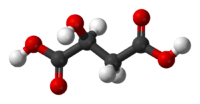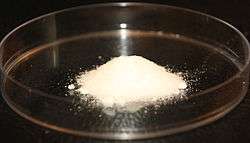Malic acid
 | |
 | |
 DL-Malic acid | |
| Names | |
|---|---|
| Preferred IUPAC name
2-Hydroxybutanedioic acid | |
| Other names
Hydroxybutanedioic acid 2-Hydroxysuccinic acid L-Malic acid D-Malic acid (–)-Malic acid (+)-Malic acid (S)-Hydroxybutanedioic acid (R)-Hydroxybutanedioic acid | |
| Identifiers | |
| 617-48-1 6915-15-7 | |
| 3D model (Jmol) | Interactive image |
| ChEBI | CHEBI:6650 |
| ChEMBL | ChEMBL1455497 |
| ChemSpider | 510 83793 D-(+)-malic acid 193317 L-(–)-malic acid |
| ECHA InfoCard | 100.027.293 |
| EC Number | 230-022-8 |
| E number | E296 (preservatives) |
| 2480 | |
| KEGG | C00149 |
| PubChem | 525 |
| UNII | 817L1N4CKP |
| |
| |
| Properties | |
| C4H6O5 | |
| Molar mass | 134.09 g·mol−1 |
| Density | 1.609 g cm−3 |
| Melting point | 130 °C (266 °F; 403 K) |
| 558 g/L (at 20 °C)[1] | |
| Acidity (pKa) | pKa1 = 3.40, pKa2 = 5.20 [2] |
| Related compounds | |
| Other anions |
malate |
| Related carboxylic acids |
succinic acid tartaric acid fumaric acid |
| Related compounds |
butanol butyraldehyde crotonaldehyde sodium malate |
| Except where otherwise noted, data are given for materials in their standard state (at 25 °C [77 °F], 100 kPa). | |
| | |
| Infobox references | |
Malic acid is an organic compound with the molecular formula C4H6O5. It is a dicarboxylic acid that is made by all living organisms, contributes to the pleasantly sour taste of fruits, and is used as a food additive. Malic acid has two stereoisomeric forms (L- and D-enantiomers), though only the L-isomer exists naturally. The salts and esters of malic acid are known as malates. The malate anion is an intermediate in the citric acid cycle.
Biochemistry
L-Malic acid is the naturally occurring form, whereas a mixture of L- and D-malic acid is produced synthetically.
-

L-Malic acid -

D-Malic acid
Malate plays an important role in biochemistry. In the C4 carbon fixation process, malate is a source of CO2 in the Calvin cycle. In the citric acid cycle, (S)-malate is an intermediate, formed by the addition of an -OH group on the si face of fumarate. It can also be formed from pyruvate via anaplerotic reactions.
Malate is also synthesized by the carboxylation of phosphoenolpyruvate in the guard cells of plant leaves. Malate, as a double anion, often accompanies potassium cations during the uptake of solutes into the guard cells in order to maintain electrical balance in the cell. The accumulation of these solutes within the guard cell decreases the solute potential, allowing water to enter the cell and promote aperture of the stomata.
Malic acid in food
Malic acid was first isolated from apple juice by Carl Wilhelm Scheele in 1785.[3] Antoine Lavoisier in 1787 proposed the name acide malique, which is derived from the Latin word for apple, mālum — as is its genus name Malus.[4][5] In German it is named Äpfelsäure (or Apfelsäure) after plural or singular of the fruit apple, but the salt(s) Malat(e). Malic acid contributes to the sourness of green apples. It is present in grapes and in most wines with concentrations sometimes as high as 5 g/l.[6] It confers a tart taste to wine, although the amount decreases with increasing fruit ripeness. The taste of malic acid is very clear and pure in rhubarb, a plant for which it is the primary flavor. It is also a component of some artificial vinegar flavors, such as "salt and vinegar" flavored potato chips.[7]
The process of malolactic fermentation converts malic acid to much milder lactic acid. Malic acid occurs naturally in all fruits and many vegetables, and is generated in fruit metabolism.[8]
Malic acid, when added to food products, is denoted by E number E296. Malic acid is the source of extreme tartness in United States-produced confectionery, the so-called extreme candy. It is also used with or in place of the less sour citric acid in sour sweets. These sweets are sometimes labeled with a warning stating that excessive consumption can cause irritation of the mouth. It is approved for use as a food additive in the EU,[9] USA[10] and Australia and New Zealand[11] (where it is listed by its INS number 296).
Malic acid provides 10 kJ (2.39 calories) of energy per gram during digestion.[12]
Production and main reactions
Racemic malic acid is produced industrially by the double hydration of maleic anhydride. In 2000, American production capacity was 5000 tons per year. Both enantiomers may be separated by chiral resolution of the racemic mixture, and the (S)- enantiomer may be specifically obtained by fermentation of fumaric acid.[13]
Self-condensation of malic acid with fuming sulfuric acid gives the pyrone coumalic acid:[14]
Malic acid was important in the discovery of the Walden inversion and the Walden cycle, in which (−)-malic acid first is converted into (+)-chlorosuccinic acid by action of phosphorus pentachloride. Wet silver oxide then converts the chlorine compound to (+)-malic acid, which then reacts with PCl5 to the (−)-chlorosuccinic acid. The cycle is completed when silver oxide takes this compound back to (−)-malic acid.
Interactive pathway map
| Click on genes, proteins and metabolites below to link to respective articles. [§ 1]
Glycolysis and Gluconeogenesis edit
|
Click on genes, proteins and metabolites below to link to respective articles. [§ 1]
TCA Cycle edit
|
See also
References
- ↑ "chemBlink Database of Chemicals from Around the World". chemblink.com.
- ↑ Dawson, R. M. C. et al., Data for Biochemical Research, Oxford, Clarendon Press, 1959.
- ↑ Carl Wilhelm Scheele (1785) "Om Frukt- och Bår-syran" (On fruit and berry acid), Kongliga Vetenskaps Academiens Nya Handlingar (New Proceedings of the Royal Academy of Science), 6 : 17-27. From page 21: " … vil jag hådanefter kalla den Åple-syran." ( … I will henceforth call it apple acid.)
- ↑ de Morveau, Lavoisier, Bertholet, and de Fourcroy, Méthode de Nomenclature Chimique (Paris, France: Cuchet, 1787), p. 108.
- ↑ The Origin of the Names Malic, Maleic, and Malonic Acid Jensen, William B. J. Chem. Educ. 2007, 84, 924. Abstract
- ↑ "Methods For Analysis of Musts and Wines", Ough and Amerine, John Wiley and Sons, 2nd Edition, 1988, page 67
- ↑ "The Science Behind Salt and Vinegar Chips". seriouseats.com.
- ↑ Malic Acid, Bartek Ingredients (retrieved 2 February 2012)
- ↑ UK Food Standards Agency: "Current EU approved additives and their E Numbers". Retrieved 2011-10-27.
- ↑ US Food and Drug Administration: "Listing of Food Additives Status Part II". Retrieved 2011-10-27.
- ↑ Australia New Zealand Food Standards Code"Standard 1.2.4 - Labelling of ingredients". Retrieved 2011-10-27.
- ↑ Greenfield, Heather; Southgate, D.A.T. (2003). Food composition data: production, management and use (2 ed.). Rome: Food and Agriculture Organization of the United Nations. p. 146. ISBN 9789251049495. Retrieved 10 February 2014.
- ↑ Karlheinz Miltenberge (2005), "Hydroxycarboxylic Acids, Aliphatic", Ullmann's Encyclopedia of Industrial Chemistry, Weinheim: Wiley-VCH, doi:10.1002/14356007.a13_507
- ↑ Richard H. Wiley and Newton R. Smith (1963). "Coumalic acid". Org. Synth.; Coll. Vol., 4, p. 201
External links
| Citric acid cycle metabolic pathway | ||||||||||||||||
|---|---|---|---|---|---|---|---|---|---|---|---|---|---|---|---|---|
| Oxaloacetate | Malate | Fumarate | Succinate | Succinyl-CoA | ||||||||||||
| |
|
|
|
|
||||||||||||
| |
|
|
|
|||||||||||||
| Acetyl-CoA | NADH + H+ | NAD+ | H2O | FADH2 | FAD | CoA + ATP(GTP) | Pi + ADP(GDP) | |||||||||
| + | H2O | |
|
NADH + H+ + CO2 | ||||||||||||
| CoA | NAD+ | |||||||||||||||
| |
H2O | |
H2O | |
NAD(P)+ | NAD(P)H + H+ | |
CO2 | |
|||||||
| |
|
|
|
|||||||||||||
| Citrate | cis-Aconitate | Isocitrate | Oxalosuccinate | α-Ketoglutarate | ||||||||||||


